Near-constant video surveillance is a fact of the modern world. Smartphones, home security cameras, dash cams, CCTV — if you’re in public, you’re probably being filmed. The question, then, is why don’t we see more cameras on airplanes?
The short answer is that they’re there.
Most travelers probably know that airplanes have exterior cameras to help pilots navigate. On many flights, these cameras also allow passengers to watch takeoffs, landings, and live feeds via their in-flight entertainment (IFE) systems. But what about cameras inside of airplane cabins?
